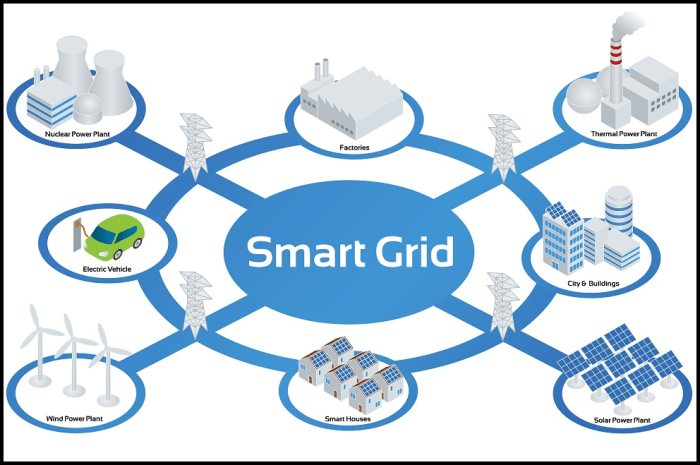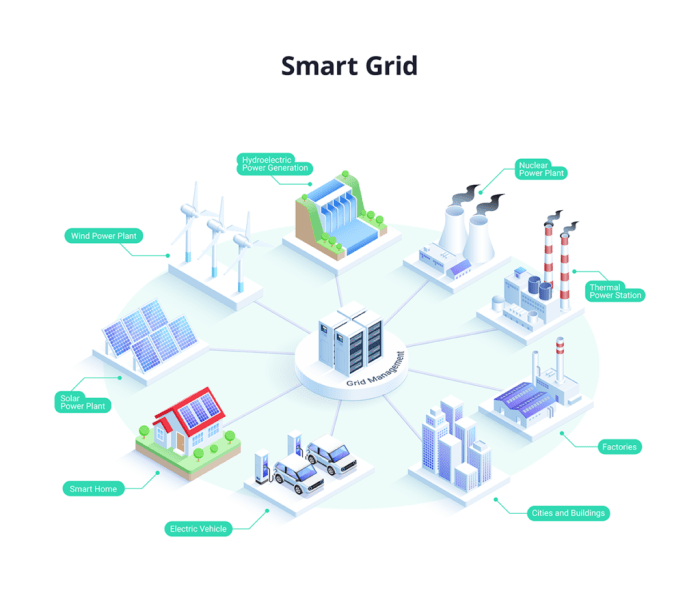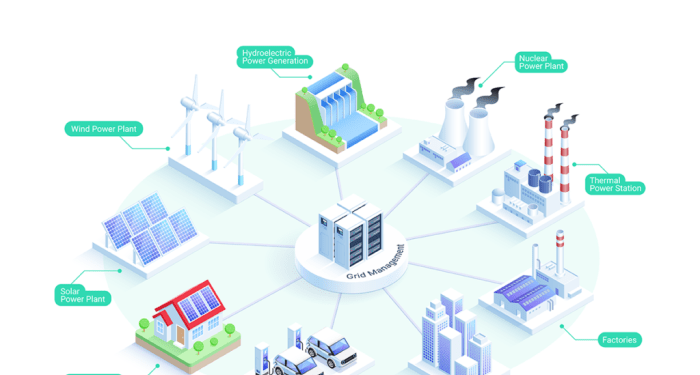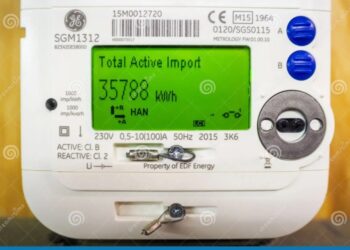Embark on a journey into the realm of Smart grid technology for electric power distribution, a cutting-edge innovation shaping the landscape of energy distribution systems. Dive into the intricate web of components and advantages that define this transformative technology.
Delve deeper into the realm of smart grids to uncover the intricacies that drive efficiency, sustainability, and reliability in the power sector.
Introduction to Smart Grid Technology

Smart grid technology refers to the modernization of electrical grids through the integration of advanced communication and control technologies. It allows for more efficient, reliable, and sustainable electricity delivery, transforming traditional power systems into more dynamic and interactive networks.
The importance of smart grid technology in modern power systems cannot be overstated. With the increasing demand for electricity, aging infrastructure, and the growing importance of renewable energy sources, smart grids play a crucial role in enhancing grid resilience, optimizing energy distribution, and accommodating the integration of renewable energy.
Key Components of a Smart Grid System
- Advanced Metering Infrastructure (AMI): Enables two-way communication between consumers and utilities, providing real-time data on energy consumption.
- Distribution Automation: Utilizes sensors and smart devices to monitor and control power distribution, reducing outages and improving reliability.
- Integration of Renewable Energy: Facilitates the seamless integration of solar, wind, and other renewable energy sources into the grid, promoting sustainability.
- Grid Monitoring and Control: Utilizes advanced analytics and control systems to optimize grid operations, enhance efficiency, and support demand response programs.
- Cybersecurity Measures: Implements robust cybersecurity protocols to protect against potential cyber threats and ensure the secure operation of the grid.
The benefits of implementing smart grid technology are numerous and impactful. These include improved reliability, increased energy efficiency, reduced operational costs, enhanced grid flexibility, and greater support for renewable energy integration.
Components of Smart Grid Technology

Smart grid technology incorporates various components to modernize and optimize electric power distribution systems. These components play crucial roles in enhancing efficiency, reliability, and sustainability in energy management.
Role of Sensors and Smart Meters
Sensors and smart meters are essential components of smart grid technology as they enable real-time monitoring and data collection. Sensors detect changes in electricity flow, voltage levels, and grid conditions, providing valuable insights for grid operators to make informed decisions.
Smart meters track energy consumption patterns, allowing consumers to manage their usage more efficiently and utilities to implement demand response programs.
Use of Advanced Communication Networks
Advanced communication networks facilitate seamless data exchange between various components of the smart grid system. These networks enable communication between sensors, smart meters, grid infrastructure, and control centers, ensuring timely responses to grid disturbances and optimizing energy flow. The integration of communication technologies like IoT and 5G enhances grid resilience and reliability.
Integration of Renewable Energy Sources
Smart grids integrate renewable energy sources such as solar, wind, and hydroelectric power to reduce reliance on fossil fuels and decrease carbon emissions. By incorporating these clean energy sources, smart grids promote sustainability and environmental conservation. Advanced forecasting models and grid management techniques help balance the intermittent nature of renewables with conventional power sources.
Importance of Energy Storage
Energy storage systems are critical components of smart grid technology, enabling efficient energy management and grid stabilization. Batteries, flywheels, and other storage devices store excess energy during off-peak hours and release it during peak demand periods, reducing strain on the grid and enhancing reliability.
Energy storage also supports the integration of renewables by storing surplus energy generated during peak production times.
Advantages of Smart Grid Technology
Smart grid technology offers numerous advantages that contribute to a more efficient and sustainable energy distribution system. By leveraging advanced digital communication and automation, smart grids provide a range of benefits that help optimize energy usage, reduce environmental impact, and enhance grid reliability.
Enhanced Energy Efficiency
Smart grid technology enables real-time monitoring and control of electricity flow, allowing utilities to better match supply with demand. This leads to more efficient energy distribution, reducing wastage and promoting energy conservation. Additionally, the implementation of smart meters and sensors helps consumers track their energy consumption patterns, encouraging better energy management practices.
Reduced Carbon Emissions
The integration of renewable energy sources into the grid is facilitated by smart grid technology, enabling a higher share of clean energy in the overall energy mix. By optimizing the use of renewable resources like solar and wind power, smart grids contribute to a significant reduction in carbon emissions and support sustainability goals.
Improved Grid Reliability and Resiliency
Smart grids are equipped with advanced monitoring and predictive maintenance capabilities, allowing utilities to detect and address issues proactively. By quickly identifying and isolating faults or disturbances, smart grids minimize downtime and improve overall grid reliability. In addition, the ability to automatically reroute power around affected areas enhances grid resiliency in the face of disruptions or disasters.
Cost Savings Associated with Smart Grid Technology
Smart grid technology helps utilities optimize their operations, leading to cost savings in various areas. For example, the implementation of demand response programs and peak load management strategies can reduce the need for expensive infrastructure upgrades. Moreover, the enhanced efficiency and reduced downtime offered by smart grids translate into cost savings for both utilities and consumers in the long run.
Challenges and Considerations in Implementing Smart Grid Technology
Smart grid technology offers numerous benefits for electric power distribution, but its implementation is not without challenges. These challenges need to be addressed to ensure the successful integration of smart grid systems.
Cybersecurity Challenges in Smart Grid Systems
Cybersecurity is a major concern in smart grid systems due to the increased connectivity and reliance on digital technologies. Hackers could potentially disrupt the grid, leading to power outages and other serious consequences. It is crucial to implement robust cybersecurity measures to protect smart grid systems from cyber threats.
Interoperability Issues Between Different Components in Smart Grids
One of the challenges in implementing smart grid technology is ensuring interoperability between various components such as sensors, meters, and control systems. Different vendors may use proprietary technologies, making it difficult to integrate these components seamlessly. Standardization efforts are essential to address interoperability issues and ensure the smooth operation of smart grid systems.
Scalability of Smart Grid Technology for Large-Scale Power Distribution
Another consideration in implementing smart grid technology is the scalability of the systems for large-scale power distribution. As the demand for electricity continues to grow, smart grid systems need to be able to handle increasing loads efficiently. Ensuring that smart grid technology can scale up to meet the needs of a rapidly expanding grid is essential for its successful deployment.
Regulatory Hurdles and Policy Implications for Smart Grid Implementation
Regulatory frameworks and policies play a crucial role in the implementation of smart grid technology. Issues such as data privacy, customer consent, and information sharing need to be addressed to comply with regulations and ensure the ethical use of data in smart grid systems.
Policy implications also impact the deployment of smart grid technology, requiring collaboration between stakeholders to navigate regulatory hurdles and promote the adoption of innovative solutions in the energy sector.
Final Wrap-Up
In conclusion, Smart grid technology for electric power distribution stands as a beacon of progress, promising a future where energy management is smarter, greener, and more resilient. Embrace the evolution of power distribution with smart grids and pave the way for a sustainable tomorrow.
Commonly Asked Questions
What are the key components of a smart grid system?
The key components include sensors, smart meters, advanced communication networks, integration of renewable energy sources, and energy storage.
How does smart grid technology enhance energy efficiency?
Smart grid technology optimizes energy usage through real-time monitoring, predictive analytics, and demand response mechanisms.
What are some common cybersecurity challenges in smart grid systems?
Cybersecurity challenges include protecting data integrity, securing communication networks, and safeguarding against cyber attacks.
What is the impact of smart grids on reducing carbon emissions?
Smart grids enable the integration of renewable energy sources, leading to a decrease in reliance on fossil fuels and a reduction in carbon emissions.














